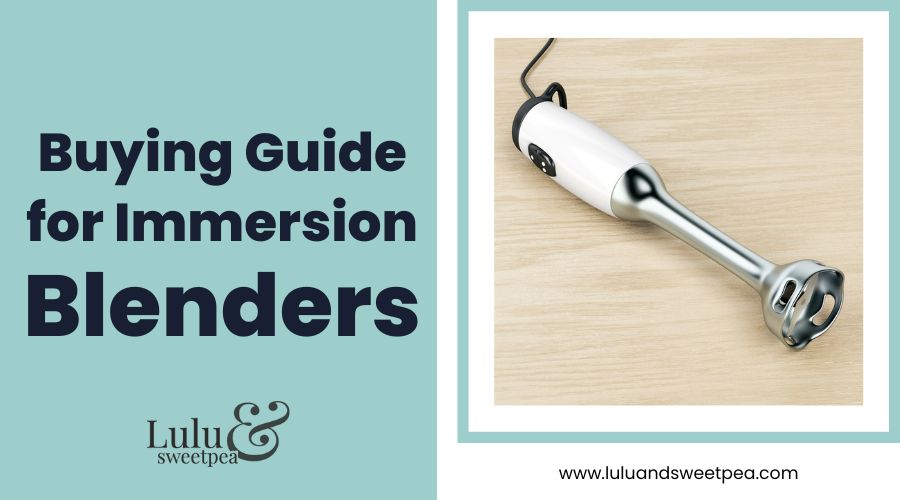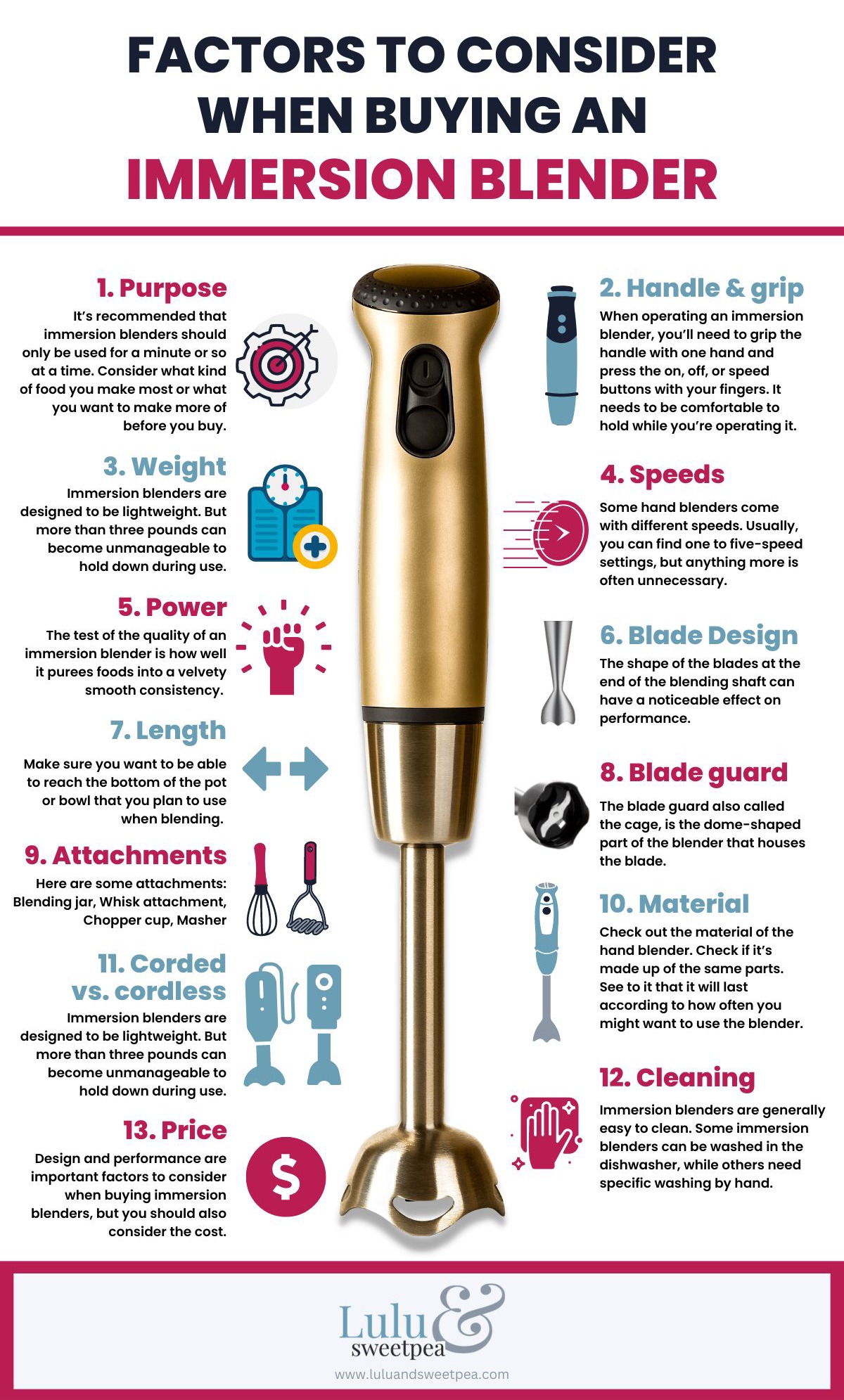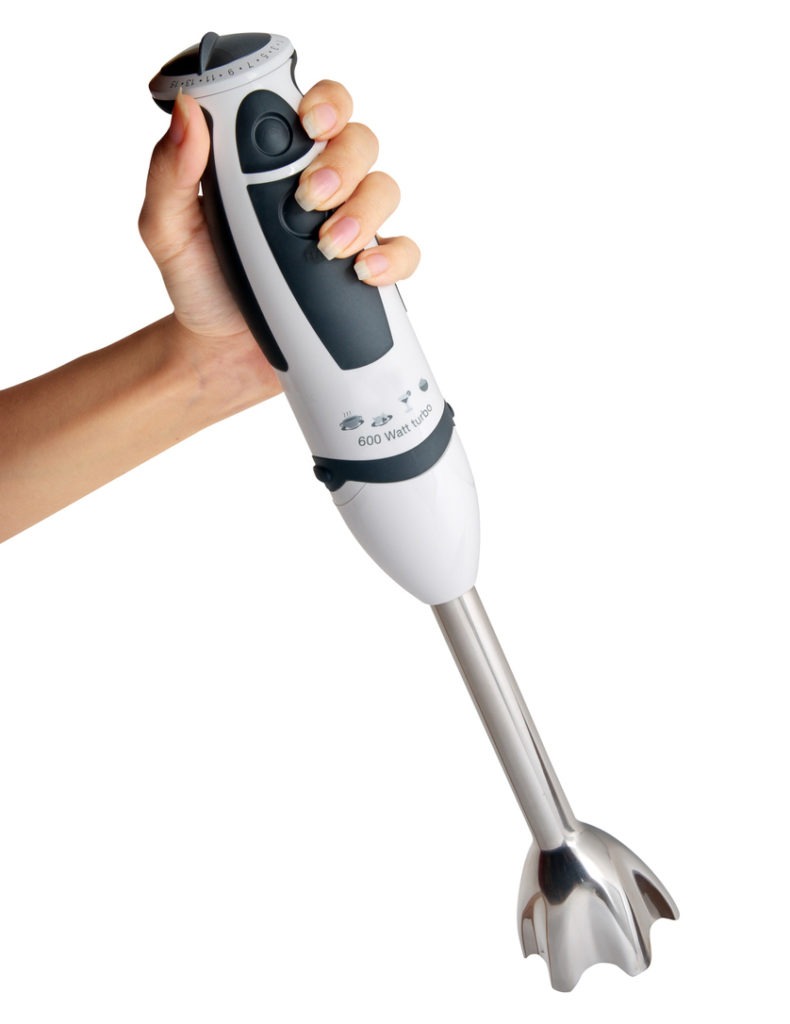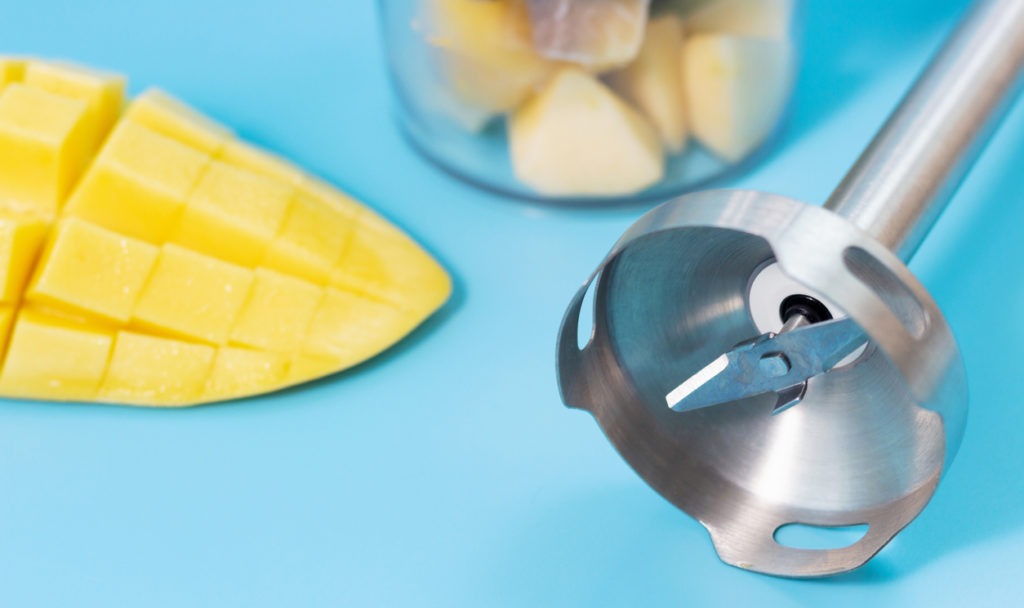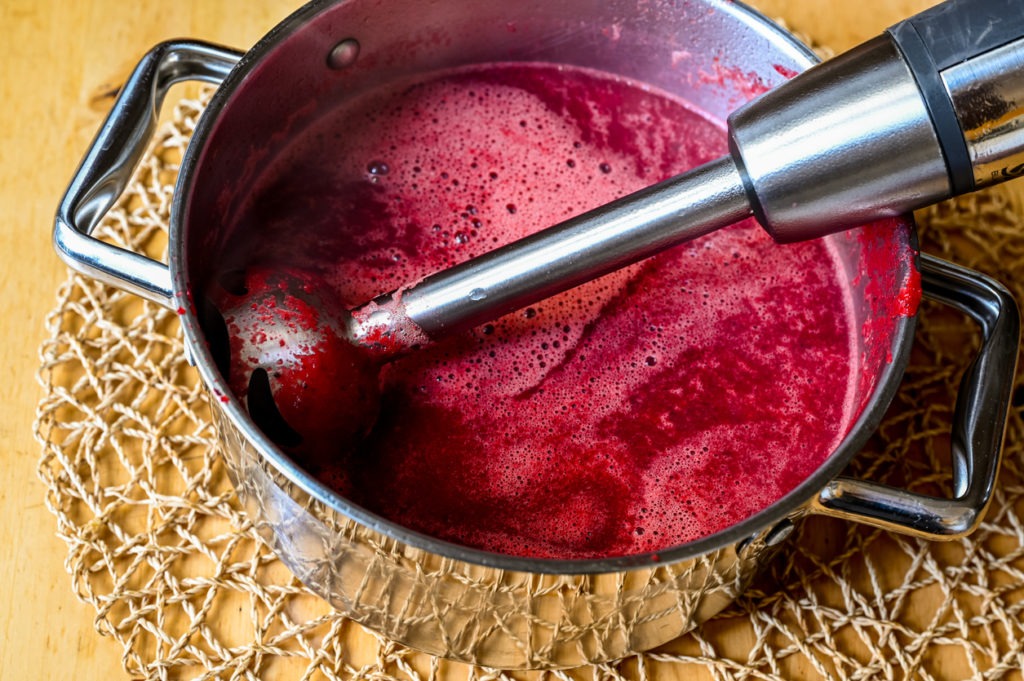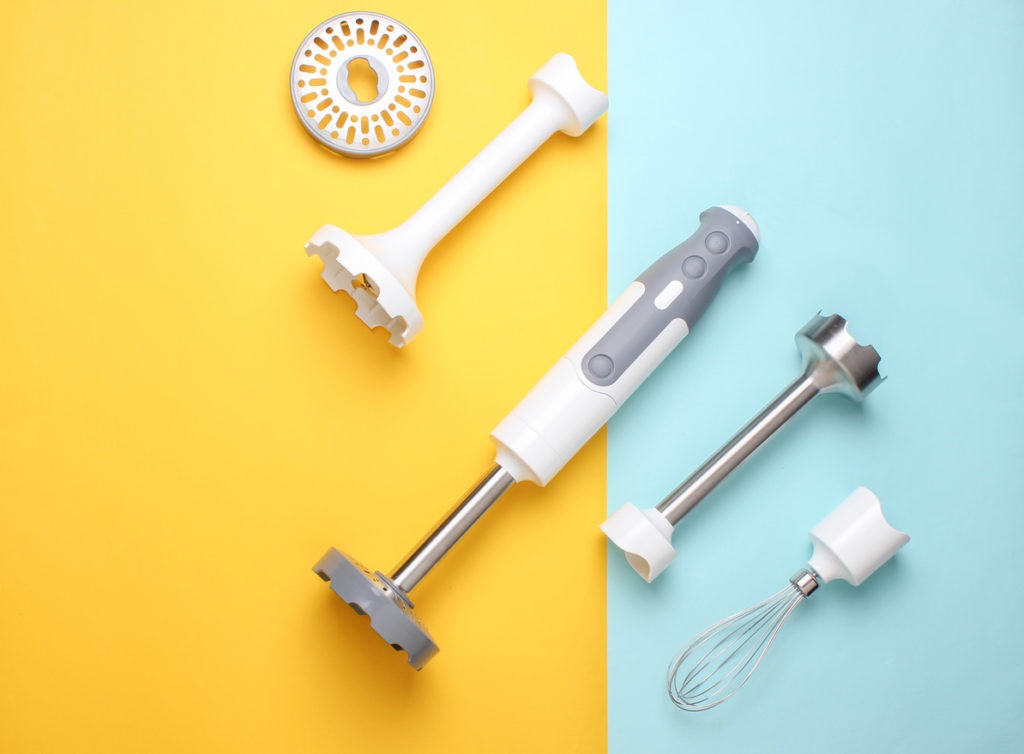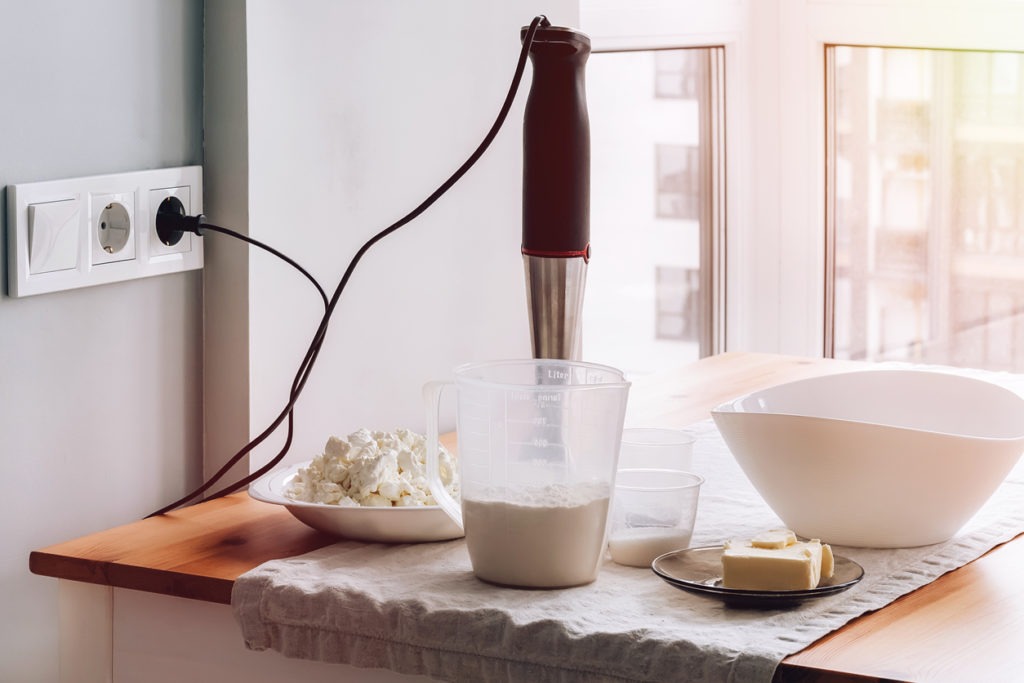While many people find storing a countertop blender in the kitchen to be worth it, the smaller immersion blender can handle many of the same tasks with less fuss. The immersion blender (also called a hand blender, stick blender, or wand blender) can help you make sauces, soups, smoothies, and spreads. It’s easier to use than traditional blenders and food processors, plus it’s even more convenient to clean and store.
What is an Immersion Blender?
An immersion blender is a hand-held blender with a small motor that you can hold in your hand, attached to a blending wand with a fan-like blade at the bottom. The motor powers the blade’s rotation to blend, mash, puree, and grind foods right from the container. Some immersion blenders are designed to be able to power attachments like mini choppers and whisks, as well.
How to Use an Immersion Blender
To use an immersion blender, hold the blender using one hand and the container of your food in the other. Insert the blade end of the wand into the food before turning it on. It creates a vortex just like in a regular blender, but the difference is you can move it up or down or side to side to help in blending.
Why Do You Need an Immersion Blender?
Adding an immersion blender is worth it if you are a lover of homemade sauces and smooth soups. It can make soups creamier, mayonnaise lighter, and milkshakes frothier. They are handy when you need to puree hot foods since you can blend them right in the pot without transferring ingredients to and from a blender. It’s also great for small jobs like making dips, pesto, mayonnaise, whipped cream, and scrambled eggs.
It’s also easy to use, quicker to clean, and more reasonable to store than a countertop blender. Quality immersion blenders can whip up milkshakes, smoothies, and frozen drinks for one or two people. However, you must avoid hard foods like nuts and seeds and fibrous foods like carrots and other root crops. Also, the immersion blender’s blades need to be fully submerged to work, so you may have trouble blending minimal quantities of food.
Factors to Consider When Buying an Immersion Blender
Before you buy an immersion blender, here are some things to consider so you won’t regret your purchase:
Purpose
What do you plan to blend with your immersion blender? Immersion blenders work best with softer foods. If you plan to use it on soups, sauces, and spreads, then an immersion blender would be useful. If you plan to use it for soups and sauces while they are simmering in the pot, then make sure you buy an immersion blender with a blending arm and blade assembly entirely made of stainless steel.
It’s recommended that immersion blenders should only be used for a minute or so at a time. Consider what kind of food you make most or what you want to make more of before you buy.
Handle and grip
When operating an immersion blender, you’ll need to grip the handle with one hand and press the on, off, or speed buttons with your fingers. It needs to be comfortable to hold while you’re operating it. Your hands will get tired easily if the handle is too large or if the buttons are too small or awkwardly placed. Ideally, your fingers must fall naturally on the buttons while you’re holding the handle. And the buttons must be easy to press without much force.
Some blenders come with ergonomic handles and soft-touch controls to make them more comfortable to use.
Weight
Immersion blenders are designed to be lightweight. But more than three pounds can become unmanageable to hold down during use, with one hand on the blender and the other adding ingredients.
Speeds
Some hand blenders come with different speeds. Usually, you can find one to five-speed settings, but anything more is often unnecessary. Most budget-friendly immersion blenders only have one or two-speed settings, and that is likely all you will need and end up using.
Power
The test of the quality of an immersion blender is how well it purees foods into a velvety smooth consistency. The higher the wattage, the more powerful the blender becomes. Immersion blenders have a wattage that ranges from 85 watts to 1,000 watts, but models with a motor that amp up to 200 to 250 watts will be powerful enough to do most blending tasks well.
The wattage does affect performance, but there are a lot of factors that come together to determine how well the blender will perform. Two models with the same amount of wattage can produce immensely varied results. The assembly of the blending shaft can vary significantly from unit to unit, which widens the gap of quality from unit to unit even more. Therefore, wattage does not reflect the performance, quality, and comfort an immersion blender can give.
Blade Design
The shape of the blades at the end of the blending shaft can have a noticeable effect on performance. Most immersion blender blades have straight edges, much like the blades of traditional blenders. This makes them skillful at crushing fruit, vegetables, and ice down to a smoothie-like consistency.
Meanwhile, blades that have a curved shape are usually added as separate attachments. The curvature of these blades is perfect for making soups, sauces, and dressings, where the blending action required is on a much smaller scale, and consistency is essential.
If you plan to blend fruits for smoothies and make creamy soups with an immersion blender, then it’s best to get a unit with different blade attachments.
Length
Make sure you want to be able to reach the bottom of the pot or bowl that you plan to use when blending. Check the length, and be sure to buy a blender with a wand long enough to reach the bottom of your stock pot. If the blade doesn’t reach the bottom of the pot, the blender will leave a layer of unprocessed ingredients.
Blade guard
The blade guard also called the cage, is the dome-shaped part of the blender that houses the blade. It’s not just a safety feature; it also controls how finely something blends. Ideally, a blade guard must have gaps or cutouts large enough to allow foods to pass through. Solid blade guards can trap food and blend it finer than you may want. Wide blade guards with large vents can circulate the food better and blends faster. It’s also easier to clean because the food stuck under it becomes more accessible. Before buying, make sure that the blade guard will fit easily in your favorite pots and smoothie cups.
Stainless steel blade guards are the best choice for longevity. Meanwhile, plastic cages might be gentler, but they may warp with heat and isn’t as durable. If most of your cookware is nonstick, you may want to look for a stainless steel blade guard with a silicone edge to avoid damaging your pots and pans.
Attachments
Most immersion blenders work with a motor that can also be connected to attachments for chopping, whisking, frothing, and processing. If you already have appliances that can do these things, you can save money by buying a model without the extras. However, a model with many attachments can be a convenient and space-saving option if you don’t own the other pieces.
Here are some attachments you may or may not need:
Blending jar:
Some hand blenders come with a tall and narrow blending jar, which can be very useful for small jobs. It helps keep the blender submerged, reduces splatter, and keeps the food close to the blades to make blending more effective. Plus, you can serve or store food in it.
Whisk attachment:
This is the most common attachment to an immersion blender. It’s a straightforward tool that can make a blender function as a hand mixer, which can be helpful if you’re baking.
Chopper cup:
Just like a food processor, many immersion blenders can use their internal motor to power a bigger blade enclosed inside a plastic chamber. By adding food to this chamber, you can activate the motor, so you can blend and create recipes like hummus without the hassle of dealing with hard-to-reach places of a traditional blender. Some immersion blender kits come with different chopping attachments of various sizes.
Masher – Mashing attachments come with wider, duller blades that have lower RPM to create a nice texture for making home-style mashed potatoes. The standard blades attached to an immersion blender often make an overly-blended potato mixture because of the small, sharp blades and high RPM. This attachment is worth it if you’re often making mashed foods at home.
Material
Check out the material of the hand blender. Check if it’s made up of the same parts. See to it that it will last according to how often you might want to use the blender.
As mentioned earlier, if you’re mostly using it for soups and other hot foods, buy a blender made from stainless steel rather than plastic. Metals are also less likely to stain and absorb smells, unlike plastic. The blending shaft is the part that gets the dirtiest, and you might find a metal shaft more convenient to use and clean.
Corded vs. cordless
There is nothing more annoying than using a hand appliance like an immersion blender and not reaching the intended area you like to work on. When using a corded immersion blender, the cord must be long enough to reach your pot while still allowing you to comfortably maneuver the appliance. The cheapest models have short and inflexible cords, which makes reaching for your dish trickier. The higher-end corded models come with an extra-long cable for convenience.
The great thing about corded blenders (at whatever price point) is that they offer constant power. However, it always has the risk of getting tangled or burned. It can also knock things over.
If you don’t like dealing with cords while blending, cordless, rechargeable immersion blenders are a good choice. However, they tend to be pricier, heavier, and run on a limited time. If it’s not fully juiced up before a task, it may lose power before you finish your job.
Cleaning
Immersion blenders are generally easy to clean. Some immersion blenders can be washed in the dishwasher, while others need specific washing by hand. If you prefer an easy cleanup, then having a dishwasher-safe attachment can save you from all the scrubbing.
Like traditional blenders, you can also use immersion blenders to clean them. Just run the blade under a pot of water to get rid of the food particles. For stubborn, stuck-on foods, you can put the blender under warm, soapy water and then turn it on. It should get rid of everything.
Make sure that the immersion blender you’re going to buy doesn’t come with food traps. There are less expensive models that come with open shafts that allow food to become trapped. Sealed shafts can make cleaning easy. Meanwhile, removable shafts can be a lot easier to clean, but they are known for issues like being fragile, breaking, or becoming loose.
Price
Design and performance are important factors to consider when buying immersion blenders, but you should also consider the cost. Higher prices might get you higher quality materials, more attachments, additional speed settings, and extra features – but it’s important to balance the bells and whistles with practicality. You can find a great model for as low as $30, and it can go for about $250.
Immersion Blender vs. Traditional Blender
Immersion blenders look a lot different from traditional countertop blenders. You may need to consider if you’ll use the immersion blender to replace or use it instead of a countertop blender. Here are the advantages of hand blenders over countertop blenders:
Lightweight:
Most immersion blenders weigh two to five pounds, and you are more likely to pull them out than a countertop blender or a heavy-duty food processor if you’re not using the appliance that much.
Convenient:
Immersion blenders allow you to bring the blender to the food, not the food to the blender. This way, you don’t need to haul food across the kitchen and pour it into your blender. In case you’re making a big batch of, let’s say, tomato soup, you don’t need to blend batch by batch – you just need to take the blender inside the big pot. This way, you won’t make another vessel dirty, thus giving you fewer things to wash during cleanup.
Easy to use:
You don’t need to set it up. Simply plug it in, place it in a pot or jar with the ingredients, and you’re good to go.
Compact:
They are smaller than a typical blender, so they are easy to store in a drawer. It’s an ideal blender of choice for small kitchens with already-cramped storage space.
Versatile:
It allows you to easily blend lots of different things, from soup to gravy, mayonnaise, whipped cream, and smoothies.
Precise:
An immersion blender allows you to make a perfectly emulsified dressing or salsa with uniformly cut chunks. This blender’s pulse control and visibility make it a good option for food preparation tasks that need care and attention.
However, many models of immersion blenders are not as powerful as traditional blenders. And though many of these blenders are marketed as being able to crush ice, traditional blenders still perform better for this task. Even an immersion blender with a strong motor can cut through frozen fruit, but not rock-hard surfaces like ice.
